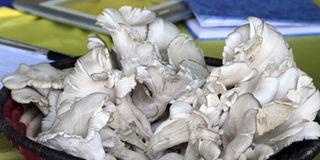Money waiting to be made in mushrooms

Mushrooms at an exhibition in Rwanda PHOTO | CYRIL NDEGEYA
What you need to know:
- Cultivation of mushrooms is a lucrative business, which can effectively contribute towards alleviating hunger and poverty, although it remains under-exploited.
- Domestic demand for mushrooms outstrips supply, with estimates of between 540 tonnes and 1200 tons annually.
Mushrooms have great health and medicinal benefits. Their benefits are the same as those of fruits and vegetables as they are rich in proteins, valuable minerals, vitamins and fibre.
They are also low in calories, have no cholesterol and are virtually free of fat and sodium.
Mushrooms are highly-recommended for diabetes and heart patients because of their high protein and low calorie content. They are also the diet of choice for those suffering from or are prone to obesity and arteriosclerosis.
All the essential amino acids required by an adult are present in mushrooms.
Demand
A number of mushrooms are used for medicinal purposes, treating a wide range of illnesses and are possible sources of new drugs.
Mushroom consumption is also said to suppress tumours.
Despite ready a market locally and abroad, the quantity of mushrooms produced in Kenya is inadequate. Production stands at 500 tonnes a year. This is supplemented by imports, which stand at about 150 tonnes yearly.
Domestic demand for mushrooms outstrips supply, with estimates of between 540 tonnes and 1200 tons annually.
Among rural communities, mushroom is used solely as a product of the wild and its availability is seasonal as determined by rainfall.
With the increasing demand for grazing and arable land, some indigenous mushroom species are disappearing due to destruction of their habitats.
Hunger and poverty
Cultivation of mushrooms is a lucrative business, which can effectively contribute towards alleviating hunger and poverty, although it remains under-exploited.
Mushrooms require little space (a few square metres of land outside the house is enough) and inputs.
The critical parameters in mushroom cultivation are high-quality spawn (seeds), high standards of hygiene, favourable temperature, humidity, light and ventilation.
The crops can be grown in a variety of structures such as grass-thatched mud house, timber or concrete houses.
The best thing about mushrooms is that they can be grown on agricultural or industrial wastes.
For instance, one can plant them on maize, beans, wheat, rice, barley, coffee, tea, bananas, sugarcane, cotton and coconut remains.
Mushrooms can also be grown on tree barks, sawdust, poultry waste and water hyacinth.
Utilisation of such waste material for cultivation is an environment-friendly disposal system. In addition, mushrooms offer little competition to other crops and livestock and their cultivation can create employment, earn income and hence reduce poverty.
Among the different types of mushrooms, Oyster mushrooms are much easier to cultivate because they are primary decomposers and can directly utilise agricultural wastes such as wheat straw.
The Oyster mushroom substrate preparation period is shorter as compared to cultivation of Button mushrooms, which are secondary decomposers and require composted material to grow.
Limiting factors
They include lack of quality seeds, high production costs, low productivity, lack of appropriate production technologies, poor marketing channels, diseases and pests.
About 80 per cent of seeds used locally are imported.
Seed production is a highly-technical undertaking requiring well-trained manpower and appropriate laboratory facilities.
Wagara and Kariuki are associate professors of plant pathology and botany, respectively, at Egerton University. Email seedsofgold egerton.ac.ke



